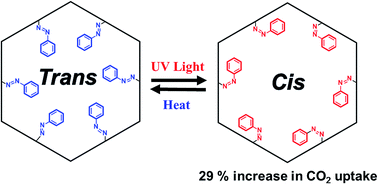Reversible tuning of pore size and CO2 adsorption in azobenzene functionalized porous organic polymers†
Abstract
A series of responsive porous organic polymers (POPs), UCBZ-1, 2, 3 and 4, comprising azobenzene moieties, were synthesized through dynamic imine chemistry and their structure–property relationship was studied. The resulting porous organic polymers showed permanent porosity with BET surface areas of around 1000 m2 g−1. More importantly, these polymers exhibit fully reversible responsive pore size distribution and CO2 uptake triggered by UV irradiation or heat treatment. We observed the transformation of some micropores with pore size around 14 Å to larger ones (17 Å) upon UV irradiation. Although the BET surface areas remain almost constant during the isomerization process, trans to cis conversion of the azobenzene groups significantly increases CO2 uptake (up to 29% at 273 K and 1 atm) of the frameworks. Our study on the structure–property relationship shows that the bulkiness of the azobenzene moieties reduces the extent of responsiveness of the materials. Such a photoresponsive behavior is largely attributed to the enhanced dipole–quadrupole interaction between CO2 and the frameworks due to the increased dipole moment of cis –N![[double bond, length as m-dash]](https://www.rsc.org/images/entities/char_e001.gif) N– groups compared to trans –N
N– groups compared to trans –N![[double bond, length as m-dash]](https://www.rsc.org/images/entities/char_e001.gif) N–. Such responsiveness significantly differs from the previously reported responsive MOFs containing azobenzene groups, which release CO2 upon trans to cis isomerization. These polymers thus represent a new class of porous polymers having intriguing stimuli-responsive properties for advanced applications.
N–. Such responsiveness significantly differs from the previously reported responsive MOFs containing azobenzene groups, which release CO2 upon trans to cis isomerization. These polymers thus represent a new class of porous polymers having intriguing stimuli-responsive properties for advanced applications.


 Please wait while we load your content...
Please wait while we load your content...